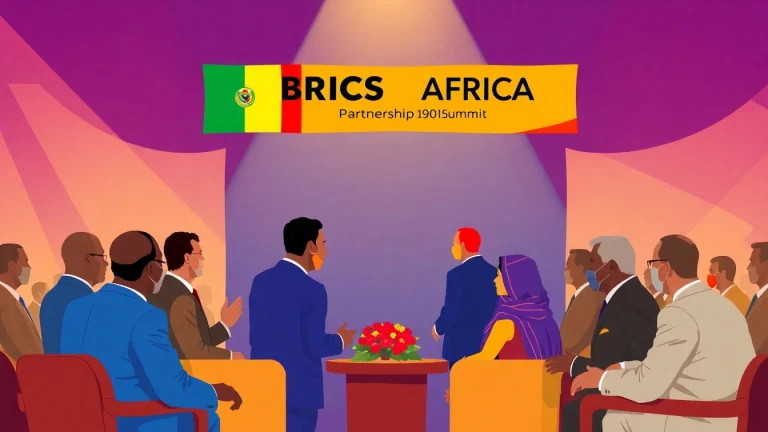
Strengthening Ties: The BRICS Africa Partnership and Its Global Implications
Understanding the BRICS Africa Partnership
The BRICS Africa partnership is a pivotal alliance in the context of global geopolitical restructuring. As African nations increasingly assert their agency in international affairs, the BRICS framework—comprising Brazil, Russia, India, China, and South Africa—is viewed as a platform for fostering economic growth and political collaboration on the continent. This partnership seeks to redefine traditional dynamics historically marked by dependency into relationships characterized by mutual benefit and empowerment. The goals set forth by BRICS are ambitious, aiming to catalyze development while paving the way for leaders on the continent to gain greater influence and control over their economic futures. As countries explore strategic collaborations, a comprehensive understanding of this partnership is essential, particularly as it pertains to fostering the BRICS Africa partnership objectives.
Overview of BRICS and Its Objectives
BRICS serves as a strategic bloc established to promote peace, security, and development while reshaping the global order. At its core, BRICS aims to create alternatives to Western-dominated financial and political systems, fostering a community that prioritizes equitable growth, innovation, and shared developmental goals. Each member brings unique resources and strengths, contributing to a robust economic bloc.
With the African continent poised as a significant player in the global economy, BRICS seeks to provide a counterbalance to Western influence, particularly in trade, investment, and sustainable development initiatives. The core objectives include:
- Promoting economic cooperation among member states and African nations.
- Enhancing trade connectivity and reducing trade barriers.
- Facilitating investment in infrastructure and technology.
- Supporting socio-economic development aligned with sustainable practices.
Key Players in the Africa Partnership
Identifying key actors within the BRICS Africa partnership is crucial to understanding the dynamics at play. Each nation brings its distinctive characteristics, fostering an environment conducive to collaboration:
- China: As a dominant player in Africa, China provides significant investments and infrastructure development through initiatives such as the Belt and Road Initiative (BRI).
- India: Capitalizing on historical ties, India is focused on technology transfer, education, and pharmaceuticals, aiming to strengthen human capital across the continent.
- Russia: With a strong emphasis on security cooperation, Russia plays a role in energy partnerships and arms sales, facilitating geopolitical alliances.
- South Africa: As the only African member, South Africa acts as a bridge between the continent and other BRICS nations, promoting South-South cooperation.
Historical Context and Development
The origins of the BRICS Africa partnership can be traced back to a need for African nations to pursue diverse economic partnerships outside of traditional Western alliances. The aftermath of colonialism and globalization has left many African countries seeking alternative routes to development.
The formation of BRICS in 2009 marked a significant historical moment, serving as an acknowledgment of the shifting dynamics in global power. Africa has been increasingly brought into these conversations, influenced by the continent’s vast resources and burgeoning markets. A series of summits has since taken place, further solidifying the relationship between BRICS member states and African nations.
Economic Impacts of BRICS in Africa
The economic implications of the BRICS Africa partnership are profound, addressing issues ranging from trade deficits to infrastructure shortcomings. Together, member nations are working to create a more balanced economic landscape across the continent.
Trade Relations and Economic Growth
Trade between BRICS nations and Africa has surged, with various agreements aimed at enhancing connectivity. This surge in trade is vital for boosting economic growth and creating jobs on the continent.
For instance, in recent years, China has become Africa’s largest trading partner, focusing on imports of raw materials and exports of manufactured goods. This relationship is complemented by India’s emphasis on pharmaceuticals and technology, enabling a diversified economic exchange that benefits both parties.
Investment Opportunities Created by the Partnership
The BRICS Africa partnership is a catalyst for generating investment opportunities throughout Africa. With commitments to improve infrastructure through investment in railways, energy, and technology, multiple projects are underway. For example, China’s deep involvement in the construction of transportation networks has minimized logistics costs, promoting intra-African trade.
Moreover, India’s focus on digital connectivity is opening new avenues for African businesses, making access to the global market more feasible. Such investments help in enhancing Africa’s investment attractiveness, allowing for sustainable economic development.
Case Studies of Successful Collaborations
Several case studies exemplify successful collaborations emerging from the BRICS Africa partnership. These instances demonstrate the tangible benefits of cooperation:
- China and Ethiopia: Collaboration in building the Addis Ababa-Djibouti railway has significantly reduced transportation costs and timeframes for goods, propelling economic growth.
- India and Rwanda: Increasing engagement through technology parks is facilitating knowledge exchange and driving digital innovation in Rwanda’s business landscape.
- Russia and South Africa: The partnership fosters cooperation in sectors such as energy and agriculture, addressing food security and energy access in rural areas.
Challenges Faced by African Nations
While the BRICS Africa partnership holds promise, various challenges must be addressed to ensure its effectiveness and sustainability. African nations are faced with several impediments that could hinder progress.
Geopolitical Tensions Affecting Collaboration
The geopolitical landscape surrounding the BRICS Africa partnership is complex. The competition between global powers creates tensions that could undermine collaborative efforts. For instance, China’s rising influence has led to apprehension among other member states, particularly India and Russia, regarding the potential for dominant economic power dynamics.
Sustainability Issues in Partnership Projects
Many projects initiated under the BRICS umbrella have faced criticism over sustainability. Concerns regarding environmental impact and local community involvement have arisen with large-scale infrastructure projects. Ensuring that initiatives respect local ecosystems while benefiting communities is vital to fostering sustainable development.
Addressing Economic Dependencies
While economic partnerships are intended to encourage independence from Western aid models, there remains a risk of creating new forms of dependency. African economies must focus on diversifying their partnerships and not relying solely on BRICS nations for support. Policies aimed at boosting local entrepreneurship and industrialization are essential.
The Future of the BRICS Africa Partnership
The future of the BRICS Africa partnership is ripe with potential. As global power structures evolve, the relationship between BRICS nations and Africa will likely deepen, marked by an increasing number of collaborative initiatives.
Emerging Trends and Predictions
As the partnership grows, emerging trends are indicative of a shift towards greater cooperation in technology, agriculture, and finance. Digital transformations are set to enhance connectivity and facilitate more dynamic economic exchanges, supporting trade while creating new business opportunities.
Potential for Expansion Beyond Current Members
The expansion of BRICS to include additional countries, especially from Africa, could reshape the partnership’s framework. Countries such as Nigeria and Egypt may seek membership, further connecting their economic interests with the collective aims of BRICS.
Strategic Recommendations for Policymakers
Policymakers must develop strategies that ensure the sustainability and effectiveness of the BRICS Africa partnership. Recommendations include:
- Encouraging inclusive participation from local communities in development projects to ensure that benefits extend to all.
- Fostering education and training initiatives that empower local populations, enhancing human capital across various sectors.
- Implementing measures to strengthen intra-Africa trade by reducing tariffs and non-tariff barriers, thereby promoting regional economic integration.
Engaging the Public and Stakeholders
Engagement from diverse stakeholders is key to unlocking the potential of the BRICS Africa partnership. Public awareness and advocacy must play a vital role in promoting the partnership’s objectives and benefits.
Raising Awareness of the Partnership’s Benefits
Efforts should focus on educating the public about the potential advantages of the BRICS Africa partnership. Government initiatives, media campaigns, and educational programs can help demystify the partnership and foster support among citizens.
Encouraging Local Participation and Investment
Encouraging local businesses to engage with BRICS initiatives can enhance investment opportunities and ensure that projects are aligned with local needs. Policy frameworks should support small and medium-sized enterprises in participating in larger projects initiated by BRICS nations.
Leveraging Media and Social Platforms for Advocacy
Utilizing media and social media platforms to advocate for the BRICS Africa partnership can raise awareness and generate support. Engaging narratives and success stories should be shared to illustrate the positive impact of collaboration on African development.


